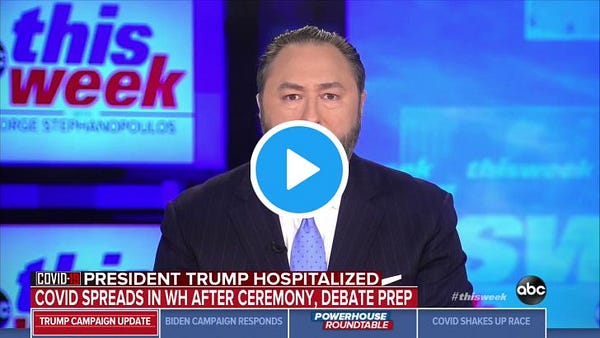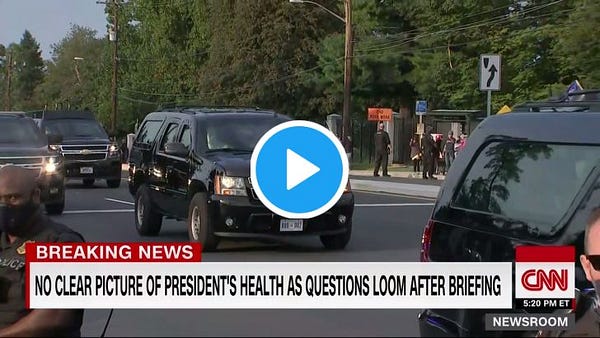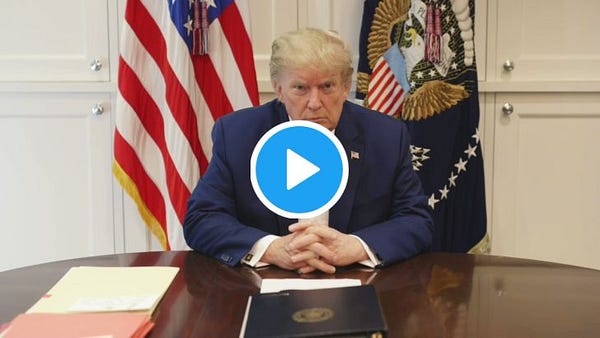So the weekend continued where Friday left off, a president in the hospital and his propaganda machine working overtime.
We saw photos and videos released from the White House doctored; we saw the president’s doctor perhaps disclose a cover up while the president’s chief of staff spoke anonymously that contradicted the doctor; we saw the president do a drive-by for his “patriot” fans putting his Secret Service detail in an uncomfortable situation; and we saw administration officials hit the Sunday talk shows and spin lie after lie.
The administration has had a credibility issue since day one when then-Press Secretary Sean Spicer lied about the size of the inauguration. Every day since, it’s been one lie after another.
In July, the Washington Post wrote that the president himself has told more than 20,000 “false or misleading” claims; that’s 23 per day.
Trump’s penchant for repeating false claims is demonstrated by the fact that the Fact Checker database has recorded nearly 500 instances in which he has repeated a variation of the same claim at least three times.
It’s one thing to be a habitual liar; it’s another when you’re the president and everything you say gets printed and aired across the world. After four years of speaking in barely comprehensible sentences, and when he does, they’re lies, it puts reporting into a tough spot—what do you cover and how do you cover it?
If the role of modern American journalism is to inform a citizenry so they can make the most informed decisions as they are choosing their elected officials, well, we have a bit of a problem. We are not informed. And that’s part of the Trump strategy, it seems. Flood the zone with as much nonsense as to confuse everyone.
It’s like we’re the living use-case for Neil Postman’s Amusing Ourselves to Death, who argued 30 years ago that the rise in television and the decline of print has caused us to be “getting sillier by the moment,” and concluded: “Like the fish who survive a toxic river and the boatmen who sail on it, there still dwell among us those whose sense of things is largely influenced by older and clearer waters.”
Today’s CNN Reliable Sources email newsletter from Brian Stelter sums the chaos and credibility gap from the administration:
I asked CNN WH correspondent Kaitlan Collins what this weekend was like. Here's what she told me: "Within 48 hours this weekend, the president's physician had to clarify a statement he made about his diagnosis timeline; the chief of staff attempted to anonymously provide information that contradicted that physician; and two communications officials contradicted each other on whether they would disclose how many White House staffers tested positive."
The dysfunction didn't end there. On Sunday, "after informing reporters there would be no further presidential movements, the White House also organized a last-minute trip for the president, violating a longstanding protocol that where the president goes, the press goes, too," Collins wrote. "And officials wouldn't tell us something as simple as when the president last received a negative test result. They wouldn't say if he was tested the day of the debate. They wouldn't say if he was tested before he flew to New Jersey Thursday. At a time when answers matter the most, taxpayer funded officials are withholding more information than they are revealing."
The Wall Street Journal reported last night that the president didn’t disclose on Thursday that he tested positive from a rapid test taken earlier that day. This wasn’t told to the WSJ from officials on the record, but instead “according to people familiar with the matter.”
This will be a lasting mark of this presidency: reporters getting leaked information because of the lack of transparency from the government, but then also filling vacuums of doubt because there are no names attached to it. It’s a viscous circle.
One part of the problem is that TV networks keep putting Trump officials on air. In some cases, over the last four years, former administration officials get cushy jobs as talking heads.


Newspapers and magazines continue to quote anonymous White House officials. The challenge is that it sows chaos while at the same time the administration bellows FAKE NEWS creating not just a credibility gap from the government, but from reporters.
The president is also fueling a strange narrative through the videos and pictures he’s been posting (and we won’t even talk about this morning’s Twitter diarrhea).
He posted this one-minute video that was clearly edited (even though Jason Miller, the guy from the ABC clip above, says it was done in one take). After the video ran on social, many editors noted that there was a glitch when he’s talking about ‘therapeutics’ (at the 1:04 mark) and say that it was edited using Adobe Fluid Morph.


In addition to looking at the doctored video, The Washington Post also peeked at the metadata of two images the president shared on social and found something curious:

Trump’s team also released photos of him apparently working from the presidential facility at Walter Reed. In one, he’s seen in the same room and outfit as in the released video. In a second image, he’s in another room, sitting at a conference table without a jacket and with numerous folders and papers in front of him. (The latter photo is above.)

Here, too, there is a bit of sleight of hand at play. The photos give the impression Trump was working for an extended period, that these photos capture various moments over the course of the day.
When you take a photograph with a modern camera or other device, however, there is information associated with the image that is stored in the image file itself. This includes information useful to photographers, like the type of camera that was used to capture the photo. It also includes information about the precise time at which the photos were taken.
The Associated Press has both photos on its website and includes the above metadata about when the photos were captured. The one showing Trump wearing his jacket was created at 5:25 p.m. Saturday. The one without a jacket was created at 5:35 p.m. In other words, they were created 10 minutes apart.
Those times themselves may not be precisely accurate, given they rely on the camera’s internal clock, which could be off or out of date. But that the photos appear to have been taken in close temporal proximity and probably at the end of the day suggests they were more likely to be the result of a photo shoot than a spontaneous effort to document a president unencumbered by illness.
For a president who is a master at press manipulation, this has become normalized. He abuses power for photo ops to create an image he thinks works. It does, but for about a third of the nation, his base.
Which is why against medical advice, the president took the motorcade to his “patriot” fans.


While the only people in immediate risk are the Secret Service agents in the car, the broader image here is the one that resonates. He’s in a car, so that means he’s healthy! And it has been played over and over for the last 24 hours.
The Washington press corp also inadvertently adds to the propaganda. Over the weekend, Politico ran what could have been an important story about how the coronavirus has crippled Washington because of Republican negligence and malfeasance. Instead, the piece frames the problem as a both-sides-ism, where, as Eric Boehlert writes in today’s Press Run:
The claim that Both Sides haven't taken serious, painful steps to get the pandemic under control is not only completely false, it provides cover for Republicans who have made the public health crisis worse at every conceivable juncture.
All across the country, Democratic leaders on the local and national level have tried to take strong measures to help the country control the public health crisis. Democrats have generally been a model of precaution, as they put science first. And all year they've been met by Republicans who have embraced Trump's reckless message of "re-opening" the country, even as the virus rages from coast to coast. Expressing disdain for health regulations and those who abide by them ("politically correct"), the Republican Party has made a point of mocking preventative measures. (The Politico article even admits, "The Capitol is filled with Republican lawmakers who decline to wear masks.")
Trump has used the media every step of his career and has lied along the way. And now as president he uses his bully pulpit, the media, and the Republican party to push propaganda that has played a not insignificant part in more than 200,000 American deaths. The next 30 days are going to be turbulent.
Thank you for allowing me in your inbox, today and every day. If you have tips, thoughts on the newsletter, or want to hire me to help your propaganda, drop me a line. Or you can follow me on Twitter. If you enjoyed this edition of The Media Nut, please consider sharing across your social networks and get your colleagues to sign up. Thanks!
Pete Seeger, “What Did You Learn In School Today?”
Some interesting links:
For telecoms as publishers:
AT&T CEO Says Big HBO Bet Will Pay Off in Long Run (WSJ)
For platforms:
Google and Facebook hate a proposed privacy law. News publishers should embrace it. (Recode)
Former Chinese government official ran TikTok’s content policy as app went global (FT)
For creative messaging:
Inside The Lincoln Project’s war against Trump (The New Yorker)
The Proud Boys are furious that gay men have taken over #ProudBoys (Forbes)
For media criticism:
How to cover a sick old man (NYT)
Political Aides Investigate VOA White House Reporter For Anti-Trump Bias (NPR)
For ad spend:
The blue money wave in Senate races (Axios)





